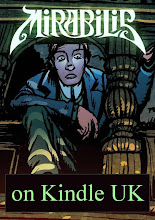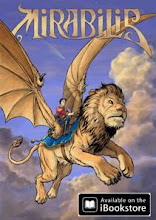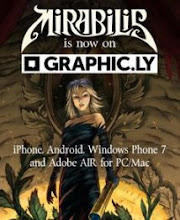 Mirabilis never had any of that sword-n-sorcery stuff. It was our deliberate policy. Mirabilis was about what happened if the imagination spilled over into everyday reality, indeed into the stuffy keep-the-lid-on reality of Victorian/Edwardian life. (Which is the same theme as Mary Poppins, now I come to think about it, although perhaps our take on it was a little different.)
Mirabilis never had any of that sword-n-sorcery stuff. It was our deliberate policy. Mirabilis was about what happened if the imagination spilled over into everyday reality, indeed into the stuffy keep-the-lid-on reality of Victorian/Edwardian life. (Which is the same theme as Mary Poppins, now I come to think about it, although perhaps our take on it was a little different.)Swords and sorcery fiction, pulpy fun though it may be, is not generally about letting the imagination off the leash. More usually, in fact, it turns out to be the most conservative of all genres, a concrete branch of fiction with carefully defined rules, more about cosiness and reassuring formalism than the often disturbing and elusive nature of true fantasy.
The only reason I feel justified in plugging the world of Abraxas on this blog is that it belongs to a branch of swords-&-sorcery that has so long fallen into disuse that it has all but regenerated itself. I refer to science fantasy, the ancient-world-flavored genre of swordplay, magic and vril-powered technology once popularized by the likes of Clark Ashton Smith, Leigh Brackett, Robert E Howard, L Sprague de Camp, Fritz Leiber Jr and Edmond Hamiliton. Devised by me and Jamie Thomson, Abraxas is the kind of swashbuckling fantasy world that kicks elves off the side of air cars and would shoot hobbits in the face with an ionic blaster (3 charges remaining).
No, it's not Tolkien nor urban/dark fantasy and it's not steampunk neither. Oh, I can't tell you how bored I am by elves and hobbits and their ilk, whether cybernetically enhanced and palely nightclubbing or prancing around dank dungeons looking for orcs to twang arrows at. Unplug the jukebox, try another flavor. In the Burgess Shale of pulp literary history, there were a few more fantasy genres than that and the blood stirred fast and hot in their veins. If you're interested to find out more, pop over to the Fabled Lands blog.
























Reading your posts Dave, particularly this one following on from the previous mention of Bram Stokes and Dark They Were and Golden Eyed, has brought back into clear focus the serried ranks of all the above authors on the shelves of that amazing shop, and the artwork for a lot of those covers was similarly beguiling.
ReplyDeleteD.T.W.A.G.E. was also the place where I picked up my first Conan comic otherwise unobtainable on these shores in 1970. Conan No. 3 "The Grim Grey God" with Barry Smith's fantastical artwork.
There was quite a stack of them, somewhat ironic as Conan No. 3 is regarded now as something of a rarity because of distribution problems affecting that issue. Presumably it was also distribution problems that prevented issues 1 and 2 appearing anywhere in the U.K.
Number 3 was the first here in the U.K. and Dark They Were was the venue to pick it up either there or via Dez Skinn's Fantasy Advertiser.
Golden days ...
Yes, indeed, Peter. Conan was the first Marvel title I actually subscribed to - something of a palaver, as it involved figuring out US postal orders with nice Mrs Pengelly at the local post office :-) And I was horrified to discover that Marvel posted the comics out folded in two. I mean, I'm not a mylar bag fanatic... but FOLDED IN TWO!?
ReplyDeleteAnyway, I remember that #3 was the first issue I got. (I never was able to track down the first two, though later saw them in reprints.) I had an exam at school that day but all I could think about was getting home and having another read of that brilliant story.
Conan immediately became my favourite comic, and my art master (Frank Brown, great guy) may have noticed that from that point my drawing took on that particularly Italianate style that Barry W-S had going (previously I'd been all Neal Adams and rangy). Mr Brown probably thought I'd been studying the Renaissance masters, not swords-n-sorcery comics!